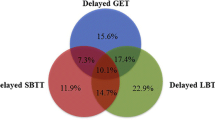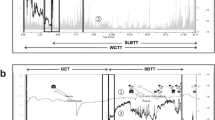Abstract
Background
The prevalence of generalized transit delay and relation to symptoms in suspected gastroparesis, intestinal dysmotility, or slow transit constipation are unknown.
Aims
The aims of this study were (1) to define prevalence of generalized dysmotility using wireless motility capsules (WMC), (2) to relate to symptoms in suspected regional delay, (3) to compare results of WMC testing to conventional transit studies to quantify new diagnoses, and (4) to assess the impact of results of WMC testing on clinical decisions.
Methods
WMC transits were analyzed in 83 patients with suspected gastroparesis, intestinal dysmotility, or slow transit constipation.
Results
Isolated regional delays were observed in 32% (9% stomach, 5% small bowel, 18% colon). Transits were normal in 32% and showed generalized delays in 35%. Symptom profiles were similar with normal transit, isolated delayed gastric, small intestinal, and colonic transit, and generalized delay (P = NS). Compared to conventional tests, WMC showed discordance in 38% and provided new diagnoses in 53%. WMC testing influenced management in 67% (new medications 60%; modified nutritional regimens 14%; surgical referrals 6%) and eliminated needs for testing not already done including gastric scintigraphy (17%), small bowel barium transit (54%), and radioopaque colon marker tests (68%).
Conclusions
WMC testing defines localized and generalized transit delays with suspected gastroparesis, intestinal dysmotility, or slow transit constipation. Symptoms do not predict the results of WMC testing. WMC findings provide new diagnoses in >50%, may be discordant with conventional tests, and can influence management by changing treatments and eliminating needs for other tests. These findings suggest potential benefits of this method in suspected dysmotility syndromes and mandate prospective investigation to further define its clinical role.



Similar content being viewed by others
References
Abell TL, Camilleri M, Donohoe K, et al. Consensus recommendations for gastric emptying scintigraphy: a joint report of the American Neurogastroenterology and Motility Society and the Society of Nuclear Medicine. Am J Gastroenterol. 2008;103:753–763.
Rao SS. Constipation: evaluation and treatment of colonic and anorectal motility disorders. Gastrointest Endosc Clin N Am. 2009;19:117–139.
Hasler WL. Gastroparesis: symptoms, evaluation, and treatment. Gastroenterol Clin North Am. 2007;36:619–647.
Hoogerwerf WA, Pasricha PJ, Kalloo AN, Schuster MM. Pain: the overlooked symptom in gastroparesis. Am J Gastroenterol. 1999;94:1029–1033.
Agrawal A, Houghton LA, Reilly B, et al. Bloating and distention in irritable bowel syndrome: the role of gastrointestinal transit. Am J Gastroenterol. 2009;104:1998–2004.
Watier A, Devroede G, Duranceau A, et al. Constipation with colonic inertia. A manifestation of systemic disease? Dig Dis Sci. 1983;28:1025–1033.
Reynolds JC, Ouyang A, Lee CA, et al. Chronic severe constipation. Prospective motility studies in 25 consecutive patients. Gastroenterology. 1987;92:414–420.
Stivland T, Camilleri M, Vassallo M, et al. Scintigraphic measurement of regional gut transit in idiopathic constipation. Gastroenterology. 1991;101:107–115.
Van der Sijp JR, Kamm MA, Nightingale JM, et al. Disturbed gastric and small bowel transit in severe idiopathic constipation. Dig Dis Sci. 1993;38:837–844.
Ghosh S, Papachrysostomou M, Batool M, Eastwood MA. Long-term results of subtotal colectomy and evidence of noncolonic involvement in patients with idiopathic slow-transit constipation. Scand J Gastroenterol. 1996;31:1083–1091.
MacDonald A, Baxter JN, Bessent RG, et al. Gastric emptying in patients with constipation following childbirth and due to idiopathic slow transit. Br J Surg. 1997;84:1141–1143.
Bassotti G, Stanghellini V, Chiarioni G, et al. Upper gastrointestinal motor activity in patients with slow-transit constipation. Further evidence for an enteric neuropathy. Dig Dis Sci. 1996;41:1999–2005.
Glia A, Lindberg G. Antroduodenal manometry findings in patients with slow-transit constipation. Scand J Gastroenterol. 1998;33:55–62.
Kuijpers HC. Application of the colorectal laboratory in diagnosis and treatment of functional constipation. Dis Colon Rectum. 1990;33:35–39.
Redmond JM, Smith GW, Barofsky I, et al. Physiological tests to predict long-term outcome of total abdominal colectomy for intractable constipation. Am J Gastroenterol. 1995;90:748–753.
Verne GN, Hocking MP, Davis RH, et al. Long-term response to subtotal colectomy in colonic inertia. J Gastrointest Surg. 2002;6:738–744.
Glia A, Akerlund JE, Lindberg G. Outcome of colectomy for slow-transit constipation in relation to presence of small-bowel dysmotility. Dis Colon Rectum. 2004;47:96–102.
Kuo B, McCallum RW, Koch KL, et al. Comparison of gastric emptying of a nondigestible capsule to a radio-labelled meal in healthy and gastroparetic subjects. Aliment Pharmacol Ther. 2008;27:186–196.
Rao SS, Kuo B, McCallum RW, et al. Investigation of colonic and whole-gut transit with wireless motility capsule and radiopaque markers in constipation. Clin Gastroenterol Hepatol. 2009;7:537–544.
Sarosiek I, Selover KH, Katz LA, et al. The assessment of regional gut transit times in healthy controls and patients with gastroparesis using wireless motility technology. Aliment Pharmacol Ther. 2010;31:313–322.
Metcalf AM, Phillips SF, Zinsmeister AR, et al. Simplified assessment of segmental colonic transit. Gastroenterology. 1987;92:40–47.
Camilleri M, Thorne KK, Ringel Y, et al. Wireless pH-motility capsule for colonic transit: prospective comparison with radiopaque markers in chronic constipation. Neurogastroenterol Motil. 2010;22:874–882.
Freeman GH, Halton JH. Note on an exact treatment of contingency, goodness of fit and other problems of significance. Biometrika. 1951;38:141–149.
Bannister JJ, Timms JM, Barfield LJ, et al. Physiological studies in young women with chronic constipation. Int J Colorectal Dis. 1986;1:175–182.
Hasler WL, Coleski R, Sarosiek I, et al. Colon transit, regional colon motor activity in diabetics with gastroparesis compared to healthy volunteers, diabetics with near normal gastric emptying (abstract). Gastroenterology. 2007;132:M2143.
Mollen RM, Kuijpers HC, Claassen AT. Colectomy for slow-transit constipation: preoperative functional evaluation is important but not a guarantee for a successful outcome. Dis Colon Rectum. 2001;44:577–580.
Zmora O, Colquhoun P, Katz J, et al. Small bowel transit does not correlate with outcome of surgery in patients with colonic inertia. Surg Innov. 2005;12:215–218.
Van der Sijp JR, Kamm MA, Nightingale JM, et al. Radioisotope determination of regional colonic transit in severe constipation: comparison with radio opaque markers. Gut. 1993;34:402–408.
Chaussade S, Khyari A, Roche H, et al. Determination of total and segmental colonic transit time in constipated patients. Results in 91 patients with a new simplified method. Dig Dis Sci. 1989;34:1168–1172.
Jankowski M, Chey WD, Maneerattanaporn M, et al. A comparison of two radioopaque marker methodologies in the assessment of colonic transit of adults with constipation (abstract). Gastroenterology. 2010;138:S231.
Kim SK. Small intestine transit time in the normal small bowel study. Am J Roentgenol. 1968;104:522–524.
Miller MA, Parkman HP, Urbain JL, et al. Comparison of scintigraphy and lactulose breath hydrogen test for assessment of orocecal transit: lactulose accelerates small bowel transit. Dig Dis Sci. 1997;42:10–18.
Hasler WL, Wilson LA, Parkman HP, et al. Bloating in gastroparesis: severity, impact, and associated factors. Am J Gastroenterol. Epub 2011/04/12.
Galil MA, Critchley M, Mackie CR. Isotope gastric emptying tests in clinical practice: expectation, outcome, and utility. Gut. 1993;34:916–919.
Soffer E, Thongsawat S. Clinical value of duodenojejunal manometry: its usefulness in diagnosis and management of patients with gastrointestinal symptoms. Dig Dis Sci. 1996;41:859–863.
Verhagen MA, Samsom M, Jebbink RJ, Smout AJ. Clinical relevance of antroduodenal manometry. Eur J Gastroenterol Hepatol. 1999;11:523–528.
Acknowledgments
Dr. Kuo has received research funding and is on the Advisory Board for SmartPill Corp. Dr. Chey is on the Advisory Board for SmartPill Corp. Dr. Wilding has served as a consultant for SmartPill Corp. Dr. Hasler has served as a consultant and has received research funding from SmartPill Corp.
Author information
Authors and Affiliations
Corresponding author
Rights and permissions
About this article
Cite this article
Kuo, B., Maneerattanaporn, M., Lee, A.A. et al. Generalized Transit Delay on Wireless Motility Capsule Testing in Patients with Clinical Suspicion of Gastroparesis, Small Intestinal Dysmotility, or Slow Transit Constipation. Dig Dis Sci 56, 2928–2938 (2011). https://doi.org/10.1007/s10620-011-1751-6
Received:
Accepted:
Published:
Issue Date:
DOI: https://doi.org/10.1007/s10620-011-1751-6




